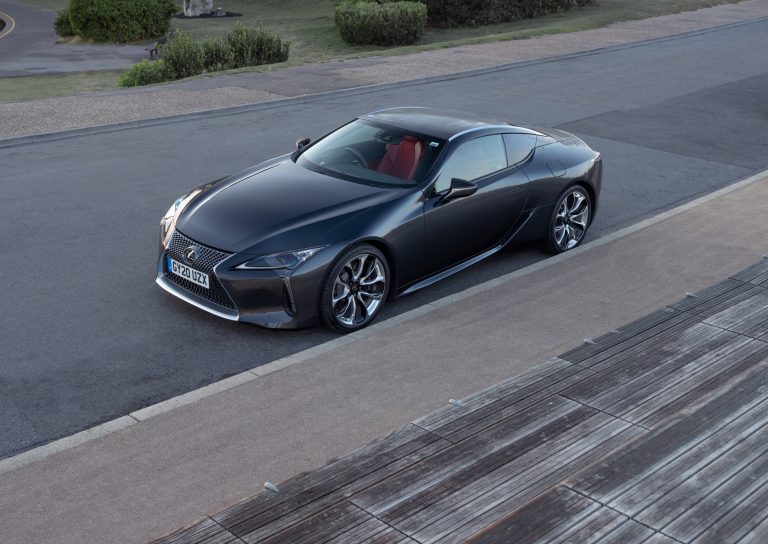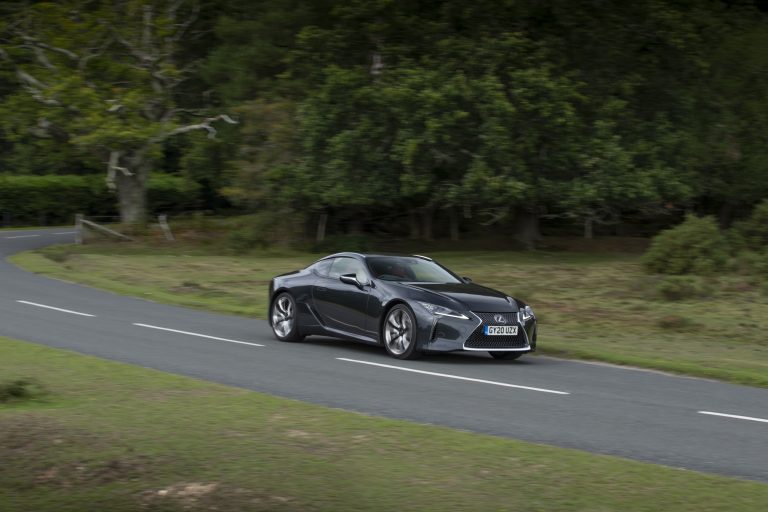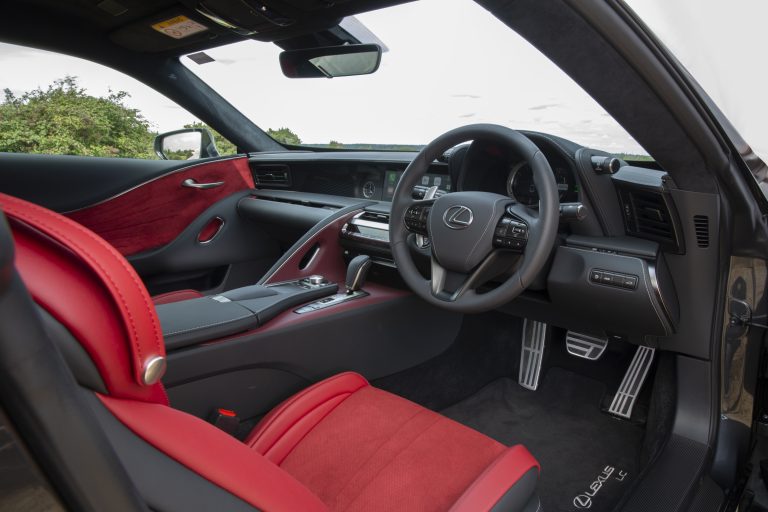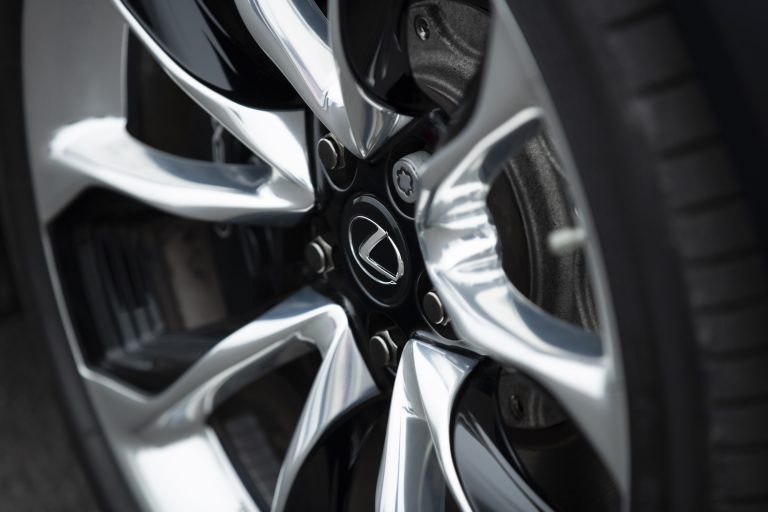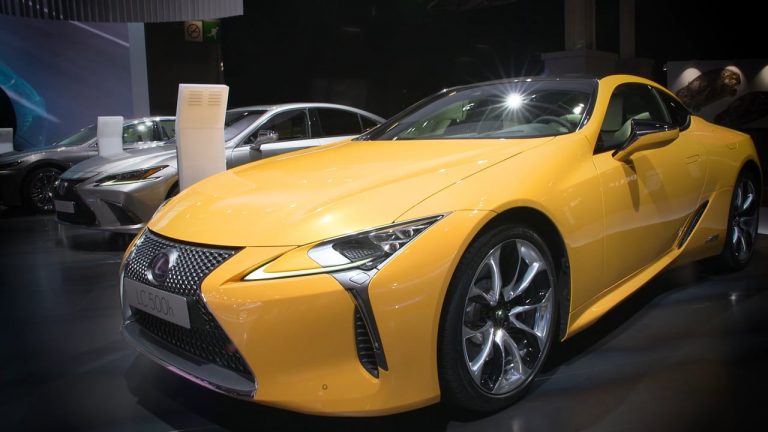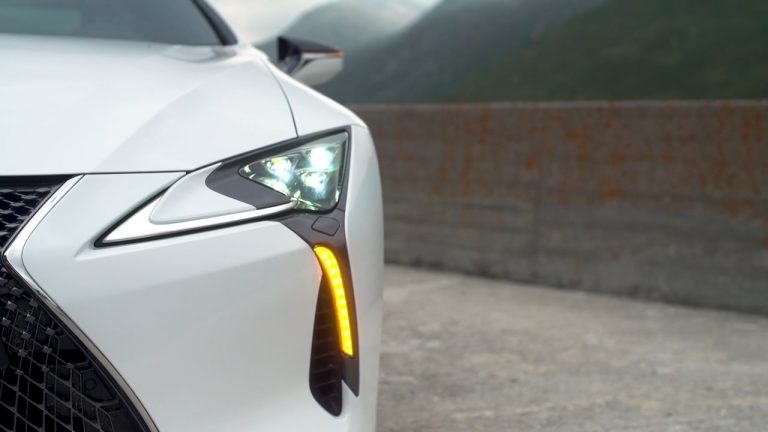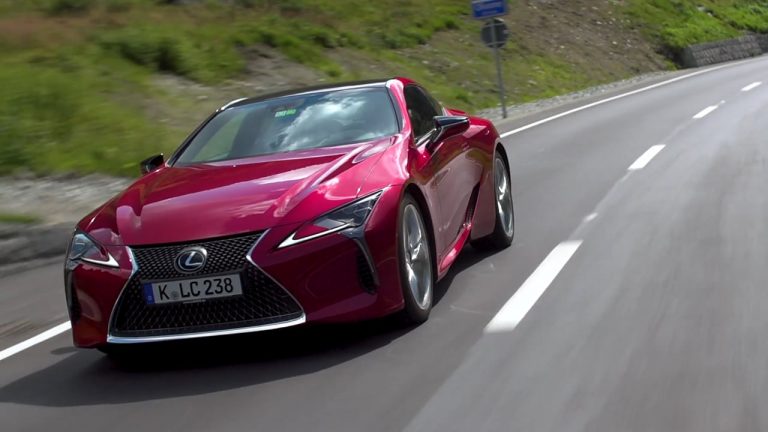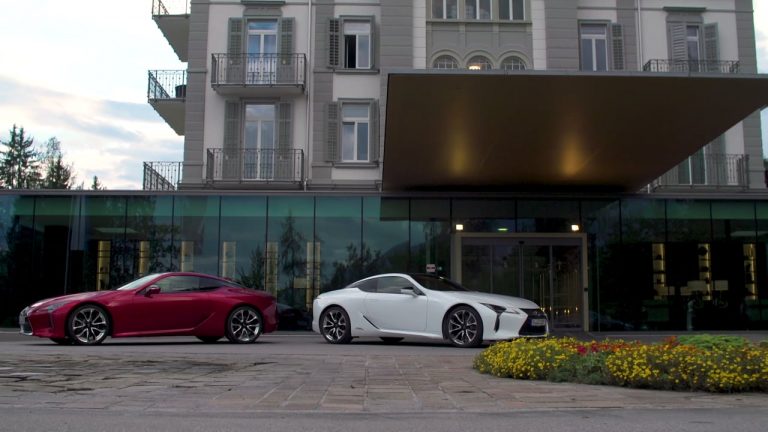World Debut of the All-new Lexus LC 500 at the Detroit Motor Show
Luxury coupe defines a new era for the global premium brand
- Styling, performance and craftsmanship help position new coupe among Lexus’s flagship models
- New vehicle architecture promises enhanced dynamic capability and performance
- LC 500 representative of an evolving Lexus vehicle development culture that embraces closer collaboration between design and engineering teams
Click here for the reveal video
Lexus today unveiled the all-new LC 500, a luxury 2+2 coupe at the Detroit motor show, a car that follows a direct, inspirational bloodline from the LF-LC Concept that excited customers, enthusiasts and the media when it broke cover at the same event four years ago. This provocative, athletic flagship model makes the strongest statement yet about the Lexus’s future product direction.
Lexus has evolved rapidly during the past five years with the creation of a globally focused organisation, Lexus International. Exciting new models delivering higher levels of emotional styling and dynamic driving characteristics, such as the NX, RC and IS, have helped propel a shift in consumers’ perceptions of the brand.
Akio Toyoda has been at the centre of Lexus’s global expansion programme, personally driving closer collaboration between the design, engineering and marketing teams to help build a luxury brand that is better suited to meet the needs of the next generation of consumers.
Toyoda, Chief Branding Officer and Master Driver for Lexus, said: “The LC 500 has been an important product for Lexus and for me personally. A few years ago we decided to guide the future of Lexus with products that brought more passion and distinction to the luxury market. The new LC 500 coupe’s proportions, stunning design and performance make a strong statement about our brand’s emotional direction and will increase Lexus’s global luxury appeal.”
Design and Engineering Teams united
Beyond its styling and impactful performance, the new LC 500 symbolises the achievements that can result from closer collaboration between design and engineering teams, with a mutual commitment to problem-solving. When Akio Toyoda challenged these development groups to produce this special car, they had to overcome many of the manufacturing, design, material and dynamic obstacles that could typically compromise a vehicle’s performance targets or design vision.
The LC 500 project has been driven by a strong, appealing fundamental design target (witnessed in the LF-LC Concept). Engineering teams worked tirelessly to find new solutions that would allow as much of the concept to be retained in the production car as possible. Likewise, vehicle designers were very involved from the earliest stages of the dynamic development process to understand the engineering targets and contribute design viewpoints and potential solutions. This model benefited from additional levels of prototype build, giving both teams better opportunities to study design and engineering ideas and refine key elements.
For Lexus, the LC 500 project became much more than simply the development of a new coupe. Generating a shift in engineering processes and design ideologies, it represents the beginning of a new phase for the Lexus brand.
Koji Sato, Chief Engineer, said: “The design and engineering sides worked together on uses and obstacles that were overcome, one by one. I feel we achieved something greater than simply preserving the spirit of the concept’s design.”
Exterior Design
It is evident from first glance that the collaboration of the engineering and design teams has been successful in transferring much of the LF-LC’s design ideology to the new LC 500. The production model shares many of the concept car’s key design elements, proportions and visual dynamism. It displays an athletic, aerodynamic shape with sensual curves and a flowing, carbon fibre roof option (a glass roof is standard). These create a wide and imposing vehicle stance and a package that is both passionate and highly functional.
The frontal area presents a powerful interpretation of Lexus’s signature spindle grille, with a chrome border on three sides and a radical new 3D mesh design that varies in visual tension. The L-shaped daytime running lights sit below new triple-LED headlamp units, designed to incorporate one of the motor industry’s thinnest projectors. This allows for a low bonnet line with a short front overhang.
Functional vents are worked into the exterior design to help improve aerodynamic stability and cooling. The car’s athletic profile is characterised by a fast sloping roofline, a wind-cutting silhouette, a long (2,870mm) wheelbase, compact overhangs (920mm front, 970mm rear) and low-set bonnet. The curves and flowing lines maintain a consistent tension in the sheet metal, through to a rear end that features slim, multi-layered lamps with a lighting effect that presents a sequential L motif. A rear diffuser and optional rear spoiler help manage airflow when driving at high speed. The wheels are 20-inch machined cast aluminium or optional 21-inch forged aluminium.
Interior Design
The interior design is influenced by the dynamic luxury of the exterior with a layout that is both cockpit-focused and elegant. The driving position was calculated to invite spirited, sporting driving and help build confidence with a more intuitive layout for the controls. In fact, the driver’s hip-point was engineered to be as close as possible to the car’s centre of gravity, where feedback from the car is strongest. The front seats offer excellent support and comfort on long journeys; optional sports seats have extra bolstering for more lateral support when cornering.
The engineering team invested considerable efforts to create an engaging, even seductive atmosphere for the driver, focusing on details such as the size and angle of the steering wheel, the feel and positioning of the magnesium alloy paddle shifts and quality of the supple leather and Alcantara seat upholsteries. The door panels, centre console and dashboard structures display Lexus’s world-renowned takumi craftsmanship in their fine detailing and finish.
Tadao Mori, Chief Designer, said: “At an early stage, the designers worked with the engineers to understand their vision for the LC 500’s driving dynamics, and they incorporated this into the design. For example, we gave serious consideration to where the driver’s eyes would focus and designed the surfacing in that area to help support the driver’s mindset.
“This was one of the first projects where designers were closely involved in the dynamic engineering development, so we could understand the driving goals and support them with car’s design.”
Chassis
The mission for the LC 500’s development team was for the car to deliver a more dynamic driving experience and character unlike that of any previous Lexus model, while maintaining the superior ride quality that has always been a performance hallmark of the brand.
The coupe is the first model to use Lexus’s new rear-wheel drive platform, part of a new corporate global architecture for luxury vehicles (GA-L). The car’s underpinnings will provide the template for Lexus’s future front-engine/rear-wheel drive vehicles.
As part of their work to sharpen the car’s handling, the engineers focused on the platform’s fundamental qualities, placing most of the mass, including the engine and vehicle occupants, lower and in a more central position in the chassis, improving the centre of gravity. Internally this strategy was known as the “inertia spec”.
The driver’s hip and heel points have been set lower, the wheels have pushed out to the corners of the vehicle, with shorter overhangs, and the drivetrain mass has been located behind the front axle line to create a front-midship layout. The LC 500 uses run-flat tyres to improve packaging, reduce weight (no spare is required) and help reduce overhangs to help meet dynamic targets. The 12-volt battery has been located in the boot as part of the weight redistribution programme.
Other measures in this area include the optional carbon fibre roof, aluminium door skins mounted on a carbon fibre inner door structure and a composite boot floor. The LC 500 also represents Lexus’s most intensive use yet of high-strength steel, providing higher rigidity while reducing – and ideally positioning – vehicle mass to optimise dynamic performance. The result is a very balanced car with a near-ideal 52/48 front/rear weight distribution.
To achieve the targeted chassis performance, Lexus engineered the stiffest monocoque it has ever produced. Strategic use of lightweight, high-strength steel helps realise a high degree of torsional rigidity, with greater resistance to twisting forces than the carbon fibre-intensive LFA supercar. The platform design maintains an even level of resistance to flexural forces and a high degree of stiffness across the vehicle’s wheelbase to help create consistent, predictable handling behaviour and sharper steering responses. Special braces in the engine compartment (part of the chassis that is particularly susceptible to twisting), the use of stiff aluminium front suspension towers and the addition of a ring structure near the rear wings all help bolster the strength of key chassis structures.
Particular attention was paid to the multilink suspension system. Double ball joints on the upper and lower control arms allow for control of the smallest movements from driver inputs and road conditions. Beyond sharing the workload, the double ball joint arrangement helps optimise suspension geometry to increase wheel control and create a more precise steering response with better initial effort. To help reduce unsprung weight and improve suspension response, all but one of the control arms are made of lightweight forged aluminium.
The Detroit show car is fitted with Michelin Sport tyres: 245/40RF21 at the front and 275/35RF21 at the rear. The combination of all the handling elements produces a world-class luxury sports coupe with razor-sharp reflexes, exceptional handling balance and rock-solid stability. Furthermore, this all-new platform will be continuously improved throughout the vehicle’s lifecycle.
Chief Engineer Sato said: “We spent more than three times the usual R&D time to pursue linear steering and to find the sweet spot for road contact feel. We also focused our efforts on suspension rigidity and enhancing geometry. Thanks to advances in product engineering, we are now at a world-class level for suspension rigidity and performance when lateral G-forces are applied.”
Powertrain
Power delivery to the rear wheels is handled by a new, very well-matched set of components. The engine at the heart of the LC 500 is derived from the proven, high-revving 5.0-litre V8 that’s found in the RC F and GS F. This naturally aspirated, all-aluminium unit was selected for its smooth, linear throttle response and stirring engine note. The output target is 467hp with 527Nm of torque.
The new engine is built for durability, with lightweight, high-strength forged connecting rods and titanium valves that allow it to flourish at high revs. It features a dual intake inlet that helps breathing and allows the engine to produce its remarkable sound. Linear power delivery allows for easier control and an exhilarating drive.
Sound control valves in the exhaust system are activated during start-up, creating a robust growl when the engine comes to life. Under acceleration, a sound generator enhances the engine’s raucous note into an aural thunder that helps distinguish the LC 500 among its peers.
Power is directed to the rear wheels using a new 10-speed automatic transmission – the first of its kind to be featured in luxury car – with shift times that rival a dual-clutch transmission. The unit is smaller and lighter than some current eight-speed transmissions. The closely spaced gears provide a wide shifting bandwith, providing an ideal gear for all driving conditions. The transmission is matched to a new electric control system with software that helps anticipate the driver’s inputs by monitoring acceleration, braking and lateral G-forces.
All the LC 500’s dynamic control elements, including the transmission, power application, braking and steering, have been tuned for rhythmic operation in sports driving. Drivers will enjoy the controlled balance between the quick and smooth shifting actions, the linear application of engine power and the deceleration afforded by six-piston brake callipers.
The engineering package has endowed the LC 500 with uncommon performance for a 2+2 coupe, with a targeted nought to 60mph time of less than 4.5 seconds.
Interior Electronics
The LC 500 introduces the 2017 Lexus Multimedia package, featuring updated, faster and more flexible software that will enable future enhancements and a graphic user interface. A Mark Levinson audio package will be available, alongside a standard-fit new premium system from Pioneer. Pioneer’s engineers worked with the LC 500 body and cabin designers to improve interior sound performance.
The new model is also equipped with Lexus Safety System+, which integrates a series of active safety technologies and driver assistance systems.
Preliminary technical specifications (North American market)
| Max. power (bhp @ rpm) | 467 @ 7,100 |
| Max. torque (Nm @ rpm) | 527 @ 4,800 |
| Acceleration 0 – 60mph (sec) | <4.5 |
| Transmission | 10-speed automatic |
| Seating capacity | 4 |
| Overall length (mm) | 4,760 |
| Overall width (mm) | 1,920 |
| Overall height (mm) | 1,345 |
| Wheelbase (mm) | 2,870 |
| Front overhang (mm) | 920 |
| Rear overhang (mm) | 970 |
| Driven wheels | Rear |
| Wheels | 20in cast aluminium or 21in forged aluminium |
| Tyre sizes | 254/40RF21 front, 275/35RF21 rear 245/45RF20 front, 275/40RF20 rear |



